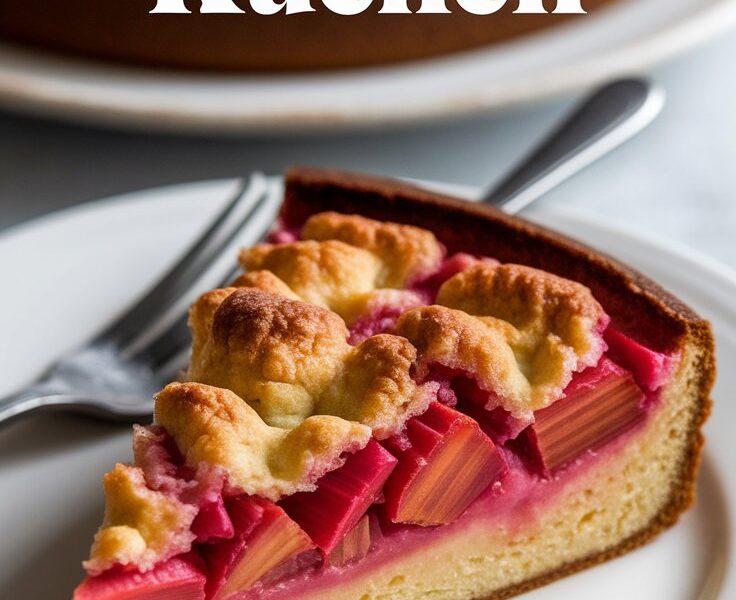Few desserts feel as comforting and celebratory as a well-made Rhubarb Custard Kuchen. At first glance, it looks simple: a golden crust, a silky custard filling, and vibrant chunks of rhubarb peeking through. But when you take that first bite, you understand why this German-inspired classic has traveled across generations, kitchens, and continents.
It’s the balance that makes it magical—sweet and tart, creamy yet firm, rustic yet elegant. Whether you’re preparing it for an Easter brunch, a spring picnic, or a cozy Sunday at home, this dessert offers more than flavor. It carries with it a sense of tradition, a nod to seasonal eating, and the kind of nostalgia that lingers long after the last crumb disappears.
In this guide, we’ll dive deep into everything you need to know about rhubarb custard kuchen: the history, ingredients, baking techniques, variations, serving ideas, and storage methods. By the end, you’ll not only have a recipe you can trust but also the confidence to make it your own.
What Is Rhubarb Custard Kuchen? The German Tradition Explained
The word Kuchen is German for “cake,” but it rarely means just a sponge or layered cake. In German and German-American kitchens, kuchen is a broad term that refers to sweet bakes that fall somewhere between a cake, pie, and tart.
Rhubarb Custard Kuchen takes that idea and turns it into a seasonal masterpiece. Traditionally, it is made with:
- A buttery shortbread-style crust
- A generous layer of fresh rhubarb
- A smooth, rich custard baked on top
When baked, the rhubarb softens and releases its tang, the custard firms just enough to hold but remains creamy, and the crust offers a sturdy yet tender base.
This dessert has strong roots in German-American immigrant communities, especially in the Midwest of the United States, where rhubarb grows abundantly in spring. It became a staple for family gatherings, church suppers, and holiday tables.
The Charm of Rhubarb in Spring Baking
Rhubarb is one of those ingredients that feels like a signal of spring. As soon as the stalks appear at markets and in gardens, bakers rush to make pies, crisps, compotes, and custards. Its bright red stalks and tangy bite bring life to desserts that might otherwise lean too sweet.
Why does rhubarb work so beautifully in custard kuchen?
- Contrast – Its tartness balances the sweetness of custard.
- Color – The ruby hues brighten the golden-yellow custard.
- Texture – Rhubarb softens as it bakes, melting into the custard without losing all its structure.
- Seasonality – Using rhubarb connects the dessert to springtime traditions.
Rhubarb is technically a vegetable, though most people treat it like fruit. That quirky identity adds to its charm—it thrives when sugar, cream, or vanilla step in to soften its edges.
Ingredients for the Perfect Rhubarb Custard Kuchen
A good kuchen doesn’t demand expensive ingredients. Instead, it relies on pantry basics, fresh produce, and a little patience. Let’s break down the components.
Choosing the Right Rhubarb
- Fresh rhubarb is best: look for firm, crisp stalks with bright red or pink coloring.
- Green rhubarb stalks are equally edible, though slightly less sweet and colorful.
- Frozen rhubarb works in a pinch—just thaw and drain thoroughly to avoid watery custard.
Crust Essentials
The crust is the backbone of kuchen. A shortbread-style base ensures richness without overpowering the custard. You’ll need:
- Unsalted butter – Softened for creaming.
- Granulated sugar – Just enough sweetness to balance the tart rhubarb.
- All-purpose flour – Provides structure.
- Salt – Enhances flavor and keeps the crust from tasting flat.
Custard Secrets
The custard is the heart of the dish. It must be rich, silky, and firm enough to slice. Here’s what makes it work:
- Eggs – Provide structure.
- Sugar – Sweetens and balances tart rhubarb.
- Flour – Helps stabilize the custard.
- Heavy cream or whole milk – Creates richness and creaminess.
- Vanilla extract – Adds warmth and aroma.
Together, these elements transform into a lush, creamy layer that contrasts beautifully with rhubarb’s tang.
Baking Tools You’ll Need
Fortunately, you don’t need fancy equipment. A few kitchen staples will do the job:
- A 9×13-inch baking dish (glass or ceramic works best)
- Mixing bowls for crust and custard
- Hand mixer or whisk for smooth custard
- Measuring cups and spoons for accuracy
- Rubber spatula for folding ingredients
- Sharp knife for chopping rhubarb
- Cooling rack for setting the baked kuchen
Step-by-Step Recipe Instructions
Here’s the reliable method to bake a traditional rhubarb custard kuchen.
Step 1: Preheat the Oven
Set your oven to 350°F (175°C). Grease your baking dish or line it with parchment paper.
Step 2: Prepare the Crust
- In a mixing bowl, cream together 1 cup (2 sticks) unsalted butter and ½ cup sugar until light and fluffy.
- Add 2 cups flour and ¼ teaspoon salt, mixing until crumbly.
- Press evenly into the bottom of the prepared dish.
Step 3: Parbake the Crust
Bake for 15 minutes, until lightly golden. Remove and let cool slightly.
Step 4: Make the Custard
- In another bowl, whisk together 3 eggs, 1½ cups sugar, and ¼ cup flour until smooth.
- Slowly add 1 cup cream (or whole milk) and 1 teaspoon vanilla.
Step 5: Add the Rhubarb
Scatter 3 cups chopped rhubarb over the crust.
Step 6: Pour Custard Over
Evenly distribute the custard mixture across the pan.
Step 7: Bake
Return to the oven for 40–45 minutes, until the custard is set but still slightly jiggly in the center.
Step 8: Cool and Chill
Allow to cool at room temperature for 30 minutes, then refrigerate before slicing.
Expert Tips for Success
Even simple desserts have nuances. These tips will help your kuchen turn out bakery-quality every time.
Preventing a Runny Custard
- Don’t underbake—the custard should be set with only a slight jiggle.
- Let the kuchen cool fully before cutting; this gives the custard time to firm.
Balancing Sweetness and Tartness
- If your rhubarb is extra tart, sprinkle a tablespoon of sugar over it before pouring the custard.
- If you prefer less sweetness, reduce sugar in the custard by ¼ cup.
Cutting Clean Slices
- Chill the kuchen for at least 2 hours before slicing.
- Use a sharp knife dipped in hot water and wiped clean between cuts.
Variations on Rhubarb Custard Kuchen
Kuchen is flexible, and bakers love experimenting. Here are creative twists:
Streusel-Topped Version
Add a crumb topping (butter, flour, brown sugar) before baking for texture.
Pretzel Crust
Swap the shortbread crust for crushed pretzels mixed with butter. The salty bite contrasts beautifully with sweet custard.
Crème Brûlée-Inspired
Once baked and chilled, sprinkle sugar on top and torch it for a caramelized crust.
Bar-Style for Potlucks
Bake in a larger sheet pan, cut into neat bars, and dust with powdered sugar for easy serving.
How Rhubarb Custard Kuchen Compares to Other Desserts
- Versus Rhubarb Pie – Kuchen is creamier and more custard-driven.
- Versus Rhubarb Crisp – Kuchen has structure and elegance, while crisps are rustic.
- Versus Custard Bars – Kuchen feels more refined, with a sturdier crust and silkier custard.
Serving Suggestions – From Casual to Elegant
- Chilled with whipped cream – Light and refreshing.
- Warm with vanilla ice cream – Comfort food perfection.
- With fresh strawberries or blueberries – Adds a burst of color and extra fruit flavor.
- Cut into bars – Ideal for brunch buffets or parties.
Storing, Reheating, and Freezing
- Refrigerate: Cover and chill up to 4 days.
- Reheat: Warm gently in a 300°F oven for 10 minutes.
- Freeze: Wrap slices in plastic and foil, freeze up to 2 months, thaw overnight in the fridge.
Nutrition Profile (Per Slice)
Approximate values (based on 10 servings):
- Calories: 310
- Fat: 16 g
- Saturated Fat: 10 g
- Carbohydrates: 39 g
- Sugar: 28 g
- Protein: 4 g
- Fiber: 1 g
- Sodium: 110 mg
- Vitamin C: 6% DV
- Calcium: 8% DV
FAQs About Rhubarb Custard Kuchen
Q: Can I use frozen rhubarb?
A: Yes—just thaw and drain it well.
Q: Why did my custard crack?
A: It was likely overbaked or cooled too quickly. Bake until just set and cool gradually.
Q: Can I use a pie crust instead of shortbread?
A: Yes, but it will resemble a tart more than a kuchen.
Q: Is this best served warm or cold?
A: Traditionally cold, but warm with ice cream is delicious.
Q: Can it be made gluten-free?
A: Yes—use a 1:1 gluten-free flour substitute.
Cultural Roots: Kuchen in German-American Kitchens
In the late 19th and early 20th centuries, German immigrants brought their baking traditions to the U.S., particularly to the Midwest. Rhubarb, which grew easily in home gardens, became a natural match for custard kuchen.
Church gatherings, weddings, and Sunday dinners often featured variations of this dessert. Even today, in states like North Dakota, South Dakota, and Minnesota, kuchen is considered a cultural treasure.
Final Thoughts – Why This Recipe Belongs in Your Collection
Rhubarb Custard Kuchen isn’t just a recipe—it’s a bridge between generations, a celebration of spring, and proof that simple ingredients can create extraordinary results.
With its buttery crust, creamy custard, and tart rhubarb, it balances flavors and textures in a way few desserts can. Once you make it, it’s hard not to come back to it every rhubarb season.



